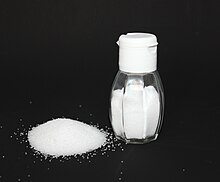Chemical species
Chemical speciesare a specific form ofchemical substanceor chemically identicalmolecular entitiesthat have the same molecular energy level at a specified timescale. These entities are classified through bonding types and relative abundance ofisotopes.[1]Types of chemical species can be classified based on the type ofmolecular entityand can be either an atomic, molecular, ionic or radical species.
Classification[edit]
Generally, a chemical species is defined as a chemical identity that has the same set of molecular energy levels in a defined timescale (i.e. an experiment). These energy levels determine the way the chemical species will interact with others through properties such as bonding or isotopic compositions. The chemical species can be an atom, molecule, ion, or radical, with a specificchemical nameandchemical formula.[2]
Insupramolecular chemistry,chemical species are structures created by forming or breaking bonds between molecules, such ashydrogen bonding,dipole-dipole bonds,etc.[3]These types of bonds can determine the physical property of chemical species in a liquid or solid state.[4]
The term is also applied to a set of chemically identical atomic or molecular structures in a solid compound.

Types of Chemical Species[edit]
Atomic species:Specific form of an element defined by the atom's isotope, electronic or oxidation state.Argonis anatomicspecies of formula Ar.[5]
Molecular species:Groups of molecules that are held together bychemical bonds.An example isozone,which has the chemical formulaO3.[6]
Ionic species:Atoms or molecules that have gained or lostelectrons,resulting in a netelectrical chargethat can be either positively (cation) or negatively charged (anion).
- Species with an overall positive charge will be a cationic species. Thesodiumion is an example of a cationic species and its formula is Na+.
- Species with an overall negative charge will be an anionic species.Chlorideis an anionic species, and its formula is Cl−.[7]
Radical species:Molecules or atoms with unpaired electrons. Triarlborane anion is aradicalspecies and its formula is Ar3B−[8][9]
Chemicals can be two different types of species. For example,nitrateis amolecularandionicspecies, with its formula being NO3−.
Note that DNA is not a species; the name is generically applied to many molecules of different formulas (each DNA molecule is unique).[10]
See also[edit]
References[edit]
- ^Qu, Ke; Dan, Dezhong (2024-01-01), Qu, Ke; Dan, Dezhong (eds.),"Chapter 3 - Chemical speciation analysis",Environmental Analytical Chemistry,Elsevier, pp. 65–100,ISBN978-0-443-21966-5,retrieved2024-04-15
- ^Chemistry (IUPAC), The International Union of Pure and Applied."IUPAC - chemical species (CT01038)".goldbook.iupac.org.doi:10.1351/goldbook.CT01038.Retrieved2024-04-01.
- ^Steed, Jonathan W.; Atwood, Jerry L. (2022-02-22).Supramolecular Chemistry.John Wiley & Sons.ISBN978-1-119-58251-9.
- ^"Chapter 5: Collections of Chemical Species".UCalgary Chemistry Textbook.Retrieved2024-04-01.
- ^Chemistry (IUPAC), The International Union of Pure and Applied."IUPAC - chemical species (CT06859)".goldbook.iupac.org.doi:10.1351/goldbook.CT06859.Retrieved2024-04-12.
- ^Atkins, Peter; Paula, Julio de; Friedman, Ronald (2023),Physical Chemistry: Quanta, Matter, and Change,Oxford University Press,doi:10.1093/hesc/9780199609819.001.0001,ISBN978-0-19-199214-8,retrieved2024-04-15
- ^Szwarc, Michael; Van Beylen, Marcel (1993),"Ionic Species",Ionic Polymerization and Living Polymers,Dordrecht: Springer Netherlands, pp. 39–85,doi:10.1007/978-94-011-1478-3_2,ISBN978-94-010-4649-7,retrieved2024-04-12
- ^Su, Yuanting; Kinjo, Rei (2017-12-01)."Boron-containing radical species".Coordination Chemistry Reviews.352:346–378.doi:10.1016/j.ccr.2017.09.019.ISSN0010-8545.
- ^Hicks, Robin G., ed. (2010-07-13).Stable Radicals.Wiley.doi:10.1002/9780470666975.ISBN978-0-470-77083-2.
- ^Caruthers, Marvin H. (January 2013)."The Chemical Synthesis of DNA/RNA: Our Gift to Science".Journal of Biological Chemistry.288(2): 1420–1427.doi:10.1074/jbc.x112.442855.ISSN0021-9258.PMC3543024.PMID23223445.
